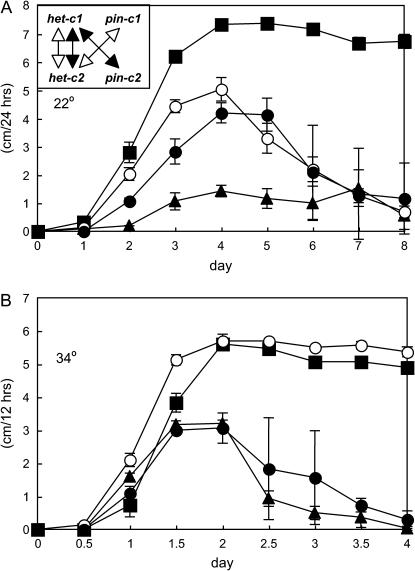Figure 5.
HI phenotype of pin-c1 and pin-c2 mutants at 22° (A) or 34° (B). (A) A RLM 57-30 (het-c1 pin-c1) + FGSC 4564 (het-c1 pin-c1) heterokaryon (▪) is fully compatible (∼7 cm/day). A FGSC 4564 (het-c1 pin-c1) + C9-2 (het-c2 pin-c2) heterokaryon (▴) is incompatible (∼1 cm/day). A FGSC 4564 (het-c1 pin-c1) + IRP228 (het-c2 pin-c2m) heterokaryon (○) initially grew at ∼5 cm/day, followed by growth arrest (∼1 cm/day). An IRO42 (het-c1 pin-c1m) and C9-2 (het-c2 pin-c2) heterokaryon (•) initially grew at ∼4 cm/day, followed by growth arrest. (B) The (RLM 57-30 + FGSC 4564) (▪) heterokaryon grew at ∼11 cm/day, while the (FGSC 4564 + C9-2) heterokaryon (▴) grew at ∼6 cm/day and underwent growth arrest. The (FGSC 4564 + IRP228) heterokaryon (○) was fully compatible (∼11 cm/day), while the (IRO42 + C9-2) heterokaryon (•) showed a phenotype similar to an incompatible control. Predicted het-c1/het-c2 allelic and het-c1/pin-c2 or het-c2/pin-c1 nonallelic interactions in the heterokaryons are indicated in the inset in A.

